Duiker W.J., Spielvogel J.J. The Essential World History. Volume 2: Since 1500
Подождите немного. Документ загружается.

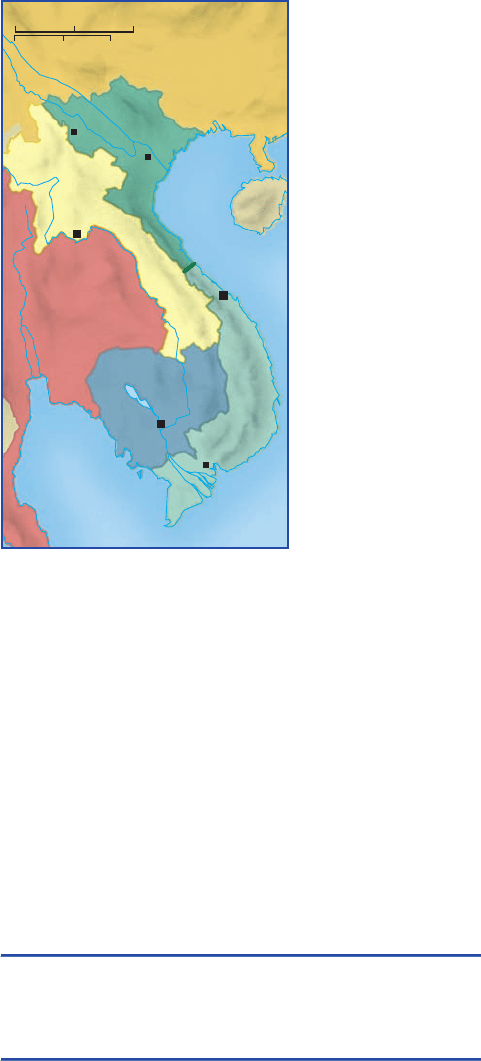
be known as the Re-
public of V ietnam).
A demilitarized zone
separated the two at
the 17th parallel.
Elections were to be
held in two years to
create a unified gov-
ernment. Cambodia
and Laos were both
declared indepen-
dent under neutral
governments. Fr ench
forces, which had
suffered a major de-
feat at the hands of
Vietminh troops at
the Battle of Dien
BienPhuinthe
spring of 1954, were
withdrawn from all
three countries.
China had
played an active
role in bringing
about the settlement and clearly hoped t hat it would
reduce tensions in the area, but subsequent effor ts to
improve relations between China a nd the United S tates
foundered on the issue of Taiwan. In the fall of 1954, the
United States signed a mutual security treaty with the
Republic of China guaranteeing U.S. militar y support in
case of an invasion of Taiwan. When Beijing demanded
U.S. withdrawal f rom Taiwan as the price for imp roved
relations, diplomatic talks between the two countries
collapsed.
From Confrontation
to Coexistence
Q
Focus Question: What events led to the era of
coexistence in the 1960s, and to what degree did each
side contribute to the reduction in international
tensions?
The decade of the 1950s opened with the world teetering
on the edge of a nuclear holocaust. The Soviet Union had
detonated its first nuclear device in 1949, and the two
blocs---capitalist and socialist---viewed each other across
an ideological divide that grew increasingly bitter with
each passing year. Yet as the decade drew to a close, a
measure of sanity crept into the Cold War, and the leaders
of the major world powers began to seek ways to coexist
in a peaceful and stable world.
The first clear sign of change occurred after Stalin’s
death in early 1953. His successor, Georgy Malenkov
(1902--1988), openly hoped to improve relations with the
Western powers in order to reduce defense expenditures
and shift government spending to growing consumer
needs. Nikita Khrushchev (1894--1971), who replaced
Malenkov in 1955, continued his predecessor’s efforts to
reduce tensions with the West and improve the living
standards of the Soviet people.
In an adroit public relations touch, in 1956 Khrushchev
promoted an appeal for a policy of peaceful coexistence
with the West. In 1955, he had surprisingly agreed to
negotiate an end to the postwar occupation of Austria by
the victorious allies and allow the creation of a neutral
country with strong cultural and economic ties with the
West. He also called for a reduction in defense expenditures
and red uced the size of the Soviet armed for ces.
Ferment in Eastern Europe
At first, Western leaders wer e suspicious of Khrushchev’ s
motives, especially in light of events that were taking place
in Eastern Eur ope. The key to security along the western
frontier of the Soviet Union was the string of Eastern
Eur opean satellite states that had been assembled in the
aftermath of World War II (see Map 26.1). Once Com-
munist domination had been assured, a series of ‘‘little
Stalins’’ put into power by Mosc o w instituted Soviet-type
five-year plans that emphasized heavy industry rather than
consumer goods, the collectivization of agriculture, and the
nationalization of industry. They also appropriated the
political tactics that Stalin had perfected in the Soviet
U nion, eliminating all non-Communist parties and
establishing the classical institutions of repression---the
secret police and military forces. Dissidents were tracked
down and thrown into prison, and ‘‘national Communists’’
who resisted total subservience to the Soviet Union were
charged with treason in mass show trials and executed.
Despite these repressive efforts, discontent became
increasingly evident in several Eastern European coun-
tries. Hungary, Poland, and Romania harbored bitter
memories of past Russian domination and suspected that
Stalin, under the guise of proletarian internationalism,
was seeking to revive the empire of the tsars. For the vast
majority of peoples in Eastern Europe, the imposition of
the so-called people’s democracies (a term invented by
Moscow to define a society in the early stage of socialist
transition) resulted in economic hardship and severe
threats to the most basic political liberties. The first in-
dications of unrest appeared in East Berlin, where popular
THAILAND
DEMOCRATIC
REPUBLIC OF
VIETNAM
REPUBLIC
OF VIETNAM
CAMBODIA
CHINA
Hanoi
Dien Bien
Phu
Saigon
Demilitarized
Zone
LAOS
Huê
Vientiane
Phnom Penh
0 100 200 Miles
0 200 400 Kilometers
Indochina After 1954
656 CHAPTER 26 EAST AND WEST IN THE GRIP OF THE COLD WAR
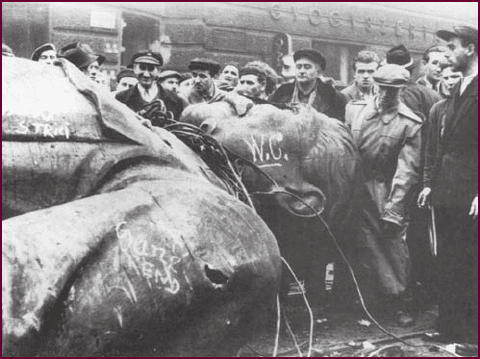
riots broke out against Communist rule in 1953. The riots
eventually subsided, but the virus had spread to neigh-
boring countries.
In Poland, public demonstrations against an increase
in food prices in 1956 escalated into widespread protests
against the regime’s economic policies, restrictions on the
freedom of Catholics to practice their religion, and
the continued presence of Soviet troops (as called for by
the Warsaw Pact) on Polish soil. In a desperate effort to
defuse the unrest, the party leader stepped down and was
replaced by Wladyslaw Gomulka (1905--1982), a popular
figure who had previously been demoted for his ‘‘na-
tionalist’’ tendencies. When Gomulka took steps to ease
the cris is, Khrushchev flew to Warsaw to warn him
against adopting policies that could undermine the po-
litical dominance of the party and weaken security links
with the Soviet Union. After a tense confrontation,
Poland agreed to remain in the Warsaw Pact and to
maintain the sanctity of party rule; in return, Gomulka
was authorized to adopt domestic reforms, such as eas-
ing restrictions on religious practice and ending the
policy of forced collectiv ization in rural areas.
The Hungarian Revolution The developments in Po-
land sent shock waves throughout the region. The impact
was strongest in neighboring Hungary, where the meth-
ods of the local ‘‘little Stalin,’’ Matyas Rakosi, were so
brutal that he had been summoned to Moscow for a
lecture. In late October 1956, student-led popular riots
broke out in the capital of Budapest and soon spread to
other towns and villages throughout the country. Rakosi
was forced to resign and was replaced by Imre Nagy
(1896--1958), a national Communist who attempted to
satisfy popular demands without arousing the anger of
Moscow. Unlike Gomulka, however, Nagy was unable to
contain the zeal of leading members of the protest
movement, who sought major political reforms and the
withdrawal of Hungary from the Warsaw Pact. On No-
vember 1, Nagy promised free elections, which, given the
mood of the country, would probably have brought an
end to Communist rule. After a brief moment of uncer-
tainty, Moscow decided on firm action. Soviet troops,
recently withdrawn at Nagy’s request, returned to Buda-
pest and installed a new government under the more
pliant party leader J
anos K
ad
ar (1912--1989). While
K
ad
ar rescinded many of Nagy’s measures, Nagy sought
refuge in the Yugoslav embassy. A few weeks later, he left
the embassy under the promise of safety but was quickly
arrested, convicted of treason, and executed.
Different Roads to Socialism The dramatic events in
Poland and Hungary graphically demonstrated the vul-
nerability of the Soviet satellite system in Eastern Europe,
and many observers throughout the world anticipated that
the United States would intervene on behalf of the free-
dom fighters in Hungary. After all, the Eisenhower ad-
ministration had promised that it would ‘‘roll back’’
communism, and radio broadcasts by the U.S.-sponsored
Radio Liberty and Radio Free Eur ope had encouraged the
peoples of Eastern E urope to rise up against Soviet dom-
ination. In reality, Washington was well aware that U.S.
intervention could lead to nuclear war and limited itself to
protests against Soviet brutality in crushing the uprising.
The year of discontent was not without consequences,
however. Soviet leaders no w recognized that Mo sco w could
maintain control over its satellites in Eastern Europe only
by granting them the leeway to adopt domestic policies
appropriate to local conditions. Khrushchev had already
embarked on this path in 1955 when he assur ed Tito that
there were ‘‘different roads to socialism.’’ Some Eastern
Eur opean Communist leaders now took Khrushchev at his
word and adopted reform programs to make socialism
more palatable to their subject populations. Even K
ad
ar,
derisively labeled the ‘‘butcher of Budapest,’’ managed to
preserve many of Nagy’s reforms to allow a measure of
capitalist incentive and freedom of expression in Hungary.
Crisis over Berlin But in the late 1950s, a new crisis
erupted over the status of Berlin. The Soviet Union had
How the Mighty Have Fa llen. In the fall of 1956, Hungarian
freedom fighters rose up against Communist domination of their country
in the short-lived Hungarian revolution. Their actions threatened Soviet
hegemony in Eastern Europe, however, and in late October, Soviet leader
Nikita Khrushchev dispatched troops to quell the uprising. In the
meantime, the Hungarian people had demonstrated their discontent by
toppling a gigantic statue of Joseph Stalin in the capital of Budapest.
Statues of the Soviet dictator had been erected in all the Soviet satellites
after World War II. (‘‘W.C.’’ identifies a public toilet in European
countries.)
AP Images
FRO M CONFRONTATION TO COEXISTENCE 657
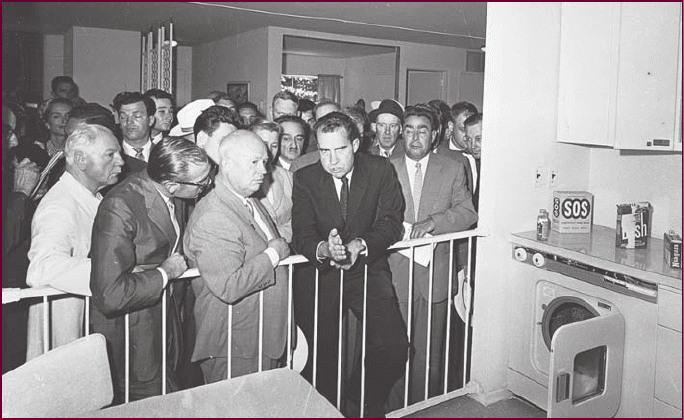
launched its first intercontinental ballistic missile (ICBM)
in August 1957, arousing U.S. fears of a missile gap be-
tween the United States and the Soviet Union. Khrush-
chev attempted to take advantage of the U.S. frenzy over
missiles to solve the problem of West Berlin, which had
remained a ‘‘Western island’’ of prosperity inside the
relatively poverty-stricken state of East Germany. Many
East Germans sought to escape to West Germany by
fleeing through West Berlin, a serious blot on the credi-
bility of the GDR and a potential source of instability in
East-West relations. In November 1958, Khrushchev an-
nounced that unless the West removed its forces from
West Berlin within six months, he would turn over con-
trol of the access routes to the East Germans. Unwilling to
accept an ultimatum that would have abandoned West
Berlin to the Communists, U.S. President Dwight D. Ei-
senhower and the West stood firm, and Khrushchev
eventually backed down.
Despite such periodic crises in East-West relations,
there were tantalizing signs that an era of true peaceful
coexistence between the two power blocs could be achieved.
In the late 1950s, the United States and the Soviet Union
initiated a cultural exchange program. While Leningrad’s
Kirov Ballet appeared at theaters in the United States,
Benny Goodman and the film West Side Story played in
Moscow. In 1958, Khrushchev visited the United States and
had a brief but friendly encounter with President Ei-
senhower at the presidential retreat in northern Maryland.
Rivalry in the Third World
Yet Khrushchev could rarely avoid
the temptation to gain an advan-
tage over the U nited States in the
competition for influence thr ough-
out the world, a posture that exac-
erbated the unstable relationship
between the two global super-
powers. U nlik e Stalin, who had
exhibited a profound distrust of all
political figures who did not slav-
ishly follow his lead, Khrushchev
viewed the dismantling of colonial
regimes in Asia, Africa, and Latin
America as a potential advantage
for the So viet Union. When neu-
tralist leaders like Nehru in India,
Tito in Yugoslavia, and Sukarno in
Indonesia founded the Nonaligned
M ov ement in 1955 as a means of
pro viding an alternative to the two
major power blocs, Khrushchev
took every opportunity to promote
Soviet interests in the Third World
(as the nonaligned countries of Asia, Africa, and Latin
America were now popularly called). Khrushchev openly
sought alliances with strategically important neutralist
countries like India, Indonesia, and Egypt, while
Washington ’s ability to influence events at the United
N ations began to wane.
In January 1961, just as John F. K ennedy (1917--1963)
assumed the U.S. presidency, Khrushchev unnerved the
new president at an informal summit meeting in Vienna
by declaring that the Soviet Union would provide active
support to national liberation movements throughout the
world. There were rising fears in Washington of Soviet
meddling in such sensitive trouble spots as Southeast
Asia, where insurgent activities in Indochina continued to
simmer; in Central Africa, where the pro-Soviet tendencies
of radical leader Patrice Lumumba aroused deep suspicion
in Washington; and in the Caribbean, where a little-known
Cuban revolutionary named Fidel Castro threatened to
transform his country into an advanced base for Soviet
expansion in the Americas.
The Cuban Missile Crisis and the Move
Toward D
etente
In 1959, a left-wing revolutionary named Fidel Castro
(b . 1927) overthrew the Cuban dictator Fulgencio Batista
and established a Soviet-supported totalitarian regime. As
tensions increased between the new government in Havana
The Kitchen Debate. During the late 1950s, the United States and the Soviet Union sought to defuse
Cold War tensions by encouraging cultural exchanges between the two countries. On one occasion, U.S.
Vice President Richard M. Nixon visited Moscow in conjunction with the arrival of an exhibit to introduce
U.S. culture and society to the Soviet people. Here Nixon lectures Soviet Communist Party chief Nikita
Khrushchev on the technology of the U.S. kitchen. On the other side of Nixon, at the far right, is future
Soviet president Leonid Brezhnev.
AP Images
658 CHAPTER 26 EAST AND WEST IN THE GRIP OF THE COLD WAR
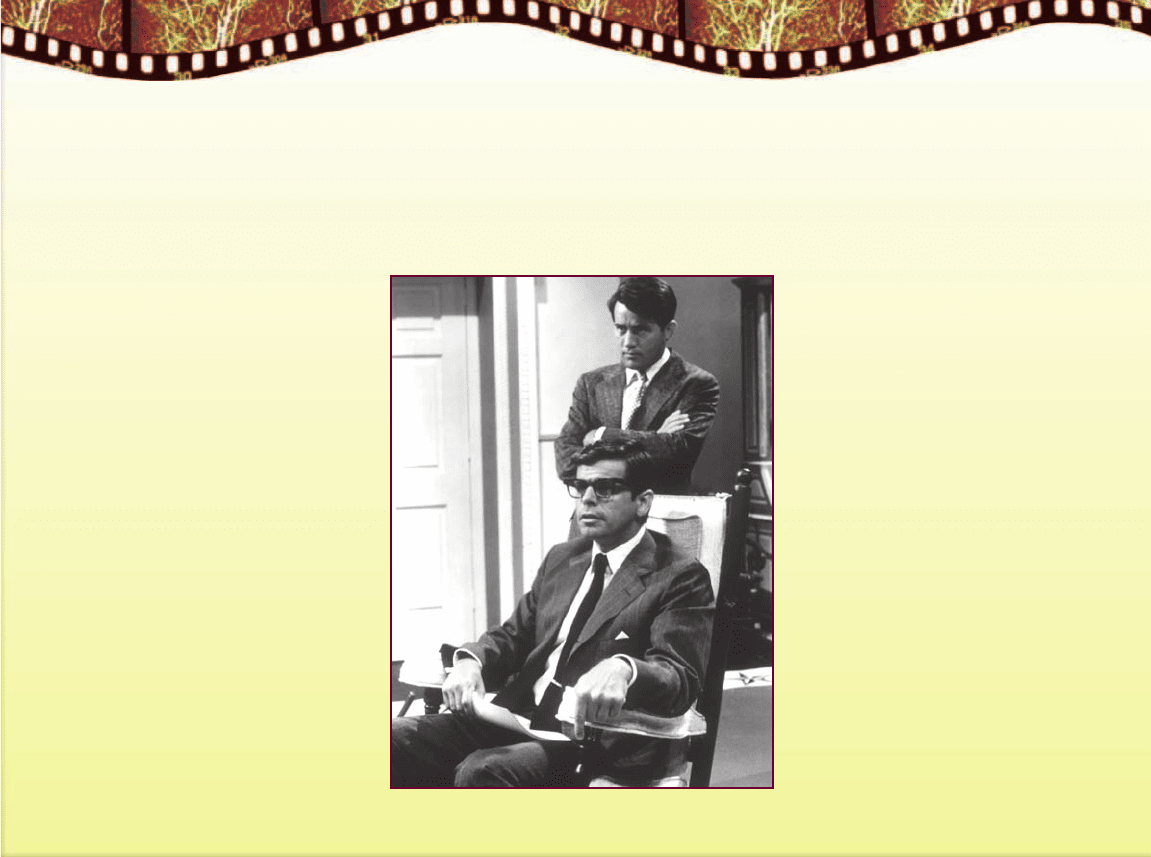
and the United States, the Eisenhower administration broke
relations with Cuba and drafted plans to overthrow Castro,
who reacted by drawing closer to Mosco w.
Soon after taking office in early 1961, Kennedy ap-
prov ed a plan to support an invasion of Cuba by anti-
Castro exiles. But the attempted landing at the Bay of Pigs
in southern Cuba was an utter failure. A t Castro ’s invita-
tion, the So viet U nion then began to station nuclear
missiles in Cuba, within striking distanc e of the American
mainland. (That the U nited States had placed nuclear
weapons in Turkey within easy range of the Soviet U nion
was a fact that Khrushchev was quick to point out.) When
U.S. intelligence discovered that a Soviet fleet carrying
more missiles was heading to Cuba, K ennedy decided to
dispatch U .S. warships into the Atlantic to prevent the fleet
from reaching its destination.
This approach to the problem was risky but had the
benefit of delaying confrontation and giving the two sides
time to find a peaceful solution. After a tense standoff
during which the two countries came frighteningly close
to a direct nuclear confrontation (the Soviet missiles
already in Cuba were launch-ready), Khrushchev finally
sent a conciliatory letter to Kennedy agreeing to turn back
the fleet if Kennedy pledged not to invade Cuba. In a
secret concession not revealed until many years later, the
president also promised to dismantle U.S. missiles in
Turkey. To the world, however (and to an angry Castro),
it appeared that Kennedy had bested Khrushchev. ‘‘We
were eyeball to eyeball,’’ noted U.S. Secretary of State
Dean Rusk, ‘‘and they blinked.’’
The ghastly realization that the world might have
faced annihilation in a matter of days had a profound
effect on both sides. A communication hotline between
Moscow and Washington was installed in 1963 to expe-
dite rapid communication between the two superpowers
in time of crisis. In the same year, the two powers agreed
to ban nuclear tests in the atmosphere, a step that served
to lessen the tensions between the two nations.
FILM & HISTORY
T
HE MISSILES OF OCTOBER (1973)
Never has the world been closer to nuclear holocaust than in the
month of October 1962, when U.S. and Soviet leaders found them-
selves in direct confrontation over Nikita Khrushchev’s decision to
introduce Soviet missiles into Cuba, just
90 miles from the coast of the United
States. When President John F. Kennedy
announced that U.S. warships would in-
tercept Soviet freighters destined for
Cuban ports, the two countries teetered
on the verge of war. Only after pro-
tracted and delicate negotiations was the
threat defused. The confrontation so-
bered leaders on both sides of the ‘‘iron
curtain’’ and led to the signing of the
first test ban treaty, as well as the open-
ing of a hotline between Moscow and
Washington.
The Missiles of October, amade-
for-TV film produced in 1973, is a
tense political drama that is all the
more riveting because it is based on
fact.Althoughitislesswellknown
than the more recent Thirteen Days,
released in 2000, i t is i n many ways
more persuasive, and the acting is
demonstrably superior. The film stars
William Devane as John F. Kennedy
and Martin Sheen as his younger
brother, Rober t. Based in part on Robert Kennedy’s Thirteen Days
(New York, 1969), a personal account of the crisis that was pub-
lished shortly after his assassination in 1968, the film traces the
tense discu ssions that took place in
the White Ho use as the president’s
key advisers debated how to respond
to the Soviet challenge. President
Kennedyremainscoolashereinsin
his more bellicose adv isers to bring
about a compromise solution that
successfully avoids the see mingly v ir-
tual certaint y of a nuclear confronta-
tion with Moscow.
Because the film is based on the
recollections of Robert F. Kennedy, it
presents a favorable portrait of his
brother’s handling of the crisis, as
might be expected, and the somewhat
triumphalist attitude at the end of the
film is perhaps a bit exaggerated. But
Khrushchev’s colleagues in the Krem-
lin and his Cuban ally, Fidel Castro,
viewed the U.S.-Soviet agreement as a
humiliation for Moscow that neverthe-
less set the two global superpowers on
the road to a more durable and peace-
ful relationship. It was one Cold War
story that had a happy ending.
John Kennedy (William Devane, seated) and Robert
Kennedy (Martin Sheen) confer with advisers.
c
Everett Collection
FRO M CONFRONTATION TO COEXISTENCE 659
The Sino-Soviet Dispute
Nikita Khrushchev had launched his slogan of peaceful
coexistence as a means of improving relations with the
capitalist powers; ironically, one result of the campaign was
to undermine Moscow’s ties with its close ally China.
During Stalin’ s lifetime, Beijing had accepted the Soviet
U nion as the acknowledged leader of the socialist camp.
After Stalin ’s death, however, relations began to deteriorate.
P art of the reason may have been Mao Zedong’s conten-
tion that he, as the most experienc ed Marxist leader ,
should now be acknowledged as the most authoritativ e
voice within the socialist community. But another deter-
mining factor was that just as Soviet policies were moving
toward moderation, China ’s were becoming more radical.
Several other issues were involved, including territo-
rial disputes along the Sino-Soviet border and China’s
unhappiness with limited Soviet economic assistance. But
the key sources of disagreement involved ideology and the
Cold War. Chinese leaders were convinced that the suc-
cesses of the Soviet space program confirmed that the
socialists were now technologically superior to the capi-
talists (the East Wind, trumpeted the Chinese official
press, had now triumphed over the West Wind), and they
urged Khrushchev to go on the offensive to promote
world revolution. Specifically, China wanted Soviet assis-
tance in retaking Taiwan from Chiang Kai-shek. But
Khrushchev was trying to improve relations with the West
and rejected Chinese demands for support against Taiwan.
By the end of the 1950s, the Soviet Union had begun
to remove its advisers from China, and in 1961, the dis-
pute broke into the open. Increasingly isolated, China
voiced its hostility to what Mao described as the ‘‘urban
industrialized countries’’ (which included the Soviet
Union) and portrayed itself as the leader of the ‘‘rural
underdeveloped countries’’ of Asia, Africa, and Latin
America in a global struggle against imperialist oppres-
sion. In effect, China had applied Mao Zedong’s concept
of people’s war in an international framework (see the
box on p. 661).
The Second Indochina War
China’s radicalism was intensified in the early 1960s by
the outbreak of renewed war in Indochina. The Ei-
senhower administration had opposed the peace settle-
ment at Geneva in 1954, which divided Vietnam
temporarily into two separate regroupment zones, spe-
cifically because the provision for future national elec-
tions opened up the possibility that the entire country
would come under Communist rule. But Eisenhower had
been unwilling to send U.S. military forces to continue
the conflict without the full support of the British and the
French, who preferred to seek a negotiated settlement.
In the end, Washington promised not to break the pro-
visions of the agreement but refused to commit itself to
the results.
During the next several months, the United States
began to provide aid to the new government in South
Vietnam. Under the leadership of the anti-Communist
politician Ngo Dinh Diem, the government began to root
out dissidents. With the tacit approval of the United
States, Diem refused to hold the national elections called
for by the Geneva Accords. It was widely anticipated, even
in Washington, that the Communists would win such
elections. In 1959, Ho Chi Minh, despairing of the
peaceful unification of the country under Communist
rule, decided to return to a policy of revolutionary war in
the south.
Late the following year, a political organization that
was designed to win the support of a wide spectrum of
the population was founded in an isolated part of South
Vietnam. Known as the National Liberation Front (NLF),
it was under the secret but firm leadership of high-
ranking Communists in North Vietnam (the Democratic
Republic of Vietnam).
By 1963, South Vietnam was on the verge of collapse.
Diem’s autocratic methods and inattention to severe
economic inequality had alienated much of the popula-
tion, and revolutionary forces, popularly known as the
Viet Cong (Vietnamese Communists) and supported by
the Communist government in the North, expanded their
influence throughout much of the country. In the fall of
1963, with the approval of the Kennedy administration,
senior military officers overthrew the Diem regime. But
factionalism kept the new military leadership from re-
invigorating the struggle against the insurgent forces, and
the situation in South Vietnam grew worse. By early 1965,
the Viet Cong, their ranks now swelled by military units
infiltrating from North Vietnam, were on the verge of
seizing control of the entire country. In March, President
Lyndon Johnson decided to send U.S. combat troops to
South Vietnam to prevent a total defeat for the anti-
Communist government in Saigon. Over the next three
years, U.S. troop levels steadily increased as the White
House counted on U.S. firepower to persuade Ho Chi
Minh to abandon his quest to unify Vietnam under
Communist leadership.
The Role of China Chinese leaders observed the gradual
escalation of the conflict in South Vietnam with mixed
feelings. They were undoubtedly pleased to have a firm
Communist ally---one that had in many ways followed the
path of Mao Zedong---just beyond their southern frontier.
Yet they were concerned that bloodshed in South Viet-
nam might enmesh China in a new conflict with the
660 CHAPTER 26 EAST AND WEST IN THE GRIP OF THE COLD WAR

OPPOSING VIEWPOINTS
P
EACEFUL COEXISTENCE OR PEOPLE’S WAR?
The Soviet leader Vladimir Lenin had contended
that war between the socialist and imperialist
camps was inevitable because the imperialists
would never give up without a fight. That assump-
tion had probably guided the thoughts of Joseph Stalin, who
told colleagues shortly after World War II that a new war
would break out in fifteen to twenty years. But Stalin’s suc-
cessor, Nikita Khrushchev, feared that a new world conflict
could result in a nuclear holocaust and contended that the
two sides must learn to coexist, although peaceful competi-
tion would continue. In this speech given in Beijing in 1959,
Khrushchev attempted to persuade the Chinese to accept his
views. But Chinese leaders argued that the ‘‘imperialist na-
ture’’ of the United States would never change and countered
that the crucial area of competition was in the Third World,
where ‘‘people’s wars’’ would bring down the structure of im-
perialism. That argument was presented in 1966 by Marshall
Lin Biao of China, at that time one of Mao Zedong’s closest
allies.
Khrushchev’s Speech to the Chinese, 1959
Comrades! Socialism brings to the people peace---that greatest bless-
ing. The greater the strength of the camp of socialism grows, the
greater will be its possibilities for successfully defending the cause of
peace on this earth. The forces of socialism are already so great that
real possibilities are being created for excluding war as a means of
solving international disputes. ...
When I spoke with President Eisenhower---and I have just
returned from the United States of America---I got the impression
that the President of the U.S.A.---and not a few people support
him---understands the need to relax international tension. ...
There is only one way of preserving peace---that is the road of
peaceful coexistence of states with different social systems. The ques-
tion stands thus: either peaceful coexistence or war with its cata-
strophic consequences. Now, with the present relation of forces
between socialism and capitalism being in favor of socialism,
he who would continue the ‘‘cold war’’ is moving towards his
own destruction. ...
It is not at all because capitalism is still strong that the socialist
countries speak out against war, and for peaceful coexistence. No,
we have no need of war at all. If the people do not want it, even
such a noble and progressive system as socialism cannot be imposed
by force of arms. The socialist countries therefore, while carrying
through a consistently peace-loving policy, concentrate their efforts
on peaceful construction; they fire the hearts of men by the force of
their example in building socialism, and thus lead them to follow in
their footsteps. The question of when this or that country will take
the path to socialism is decided by its own people. This, for us, is
the holy of holies.
Lin Biao, ‘‘Long Live the Victory of People’s War’’
Many countries and peoples in Asia, Africa, and Latin America are
now being subjected to aggression and enslavement on a serious
scale by the imperialists headed by the United States and their
lackeys. ... As in China, the peasant question is extremely impor-
tant in these regions. The peasants constitute the main force of the
national-democratic revolution against the imperialists and their
lackeys. In committing aggression against these countries, the impe-
rialists usually begin by seizing the big cities and the main lines of
communication. But they are unable to bring the vast countryside
completely under their control. ... The countryside, and the coun-
tryside alone, can provide the revolutionary basis from which the
revolutionaries can go forward to final victory. Precisely for this rea-
son, Mao Tse-tung’s theory of establishing revolutionary base areas
in the rural districts and encircling the cities from the countryside
is attracting more and more attention among the people in these
regions.
Taking the entire globe, if North America and Western Europe
can be called ‘‘the cities of the world,’’ then Asia, Africa, and Latin
America constitute ‘‘the rural areas of the world.’’ Since World War II,
the proletarian revolutionary movement has for various reasons
been temporarily held back in the North American and West Euro-
pean capitalist countries, while the people’s revolutionary movement
in Asia, Africa, and Latin America has been growing vigorously. In a
sense, the contemporary world revolution also presents a picture of
the encirclement of cities by the rural areas. In the final analysis, the
whole cause of world revolution hinges on the revolutionary strug-
gles of the Asian, African, and Latin American peoples, who make
up the overwhelming majority of the world’s population. The social-
ist countries should regard it as their internationalist duty to sup-
port the people’s revolutionary struggles in Asia, Africa, and Latin
America. ...
Ours is the epoch in which world capitalism and imperialism
are heading for their doom and communism is marching to victory.
Comrade Mao Tse-tung’s theory of people’s war is not only a prod-
uct of the Chinese revolution, but has also the characteristic of our
epoch. The new experience gained in the people’s revolutionary
struggles in various countries since World War II has provided con-
tinuous evidence that Mao Tse-tung’s thought is a common asset
of the revolutionary people of the whole world.
Q
Why did Nikita Khrushchev feel that, contrary to Lenin’s
prediction, conflict between the socialist and capitalist camps
was no longer inevitable? How did Lin Biao respond?
FRO M CONFRONTATION TO COEXISTENCE 661
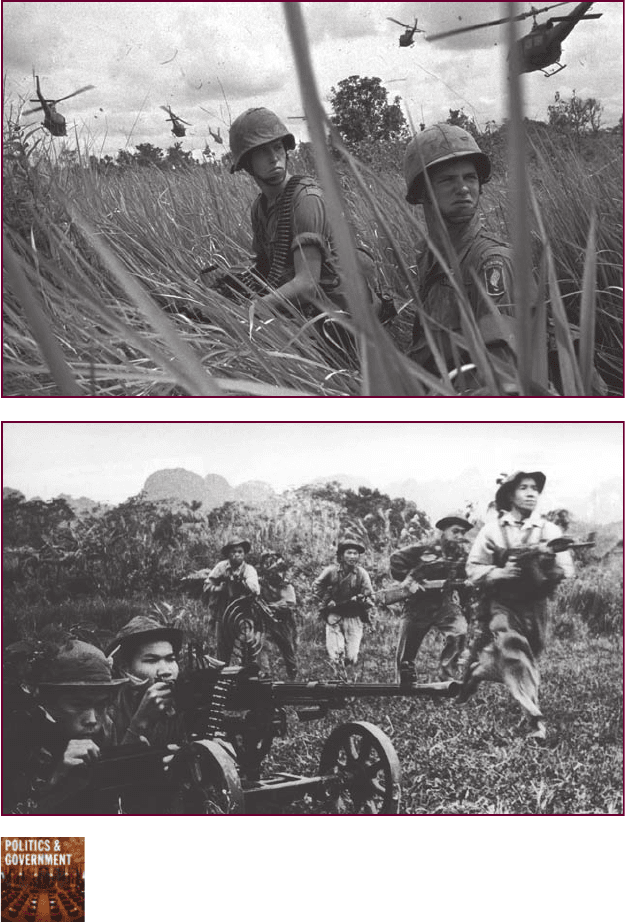
United States. Nor did they welcome the
specter of a powerful and ambitious
united Vietnam, which might wish to
extend its influence throughout mainland
Southeast Asia, an area that Beijing con-
sidered its own backyard.
Chinese leaders therefore tiptoed
delicately through the minefield of the
Indochina conflict. As the war escalated in
1964 and 1965, Beijing publicly an-
nounced that the Chinese people fully
supported their comrades seeking na-
tional liberation but privately assured
Washington that China would not directly
enter the conflict unless U.S. forces
threatened its southern border. Beijing
also refused to cooperate fully with Mos-
cow in shipping Soviet goods to North
Vietnam through Chinese territory.
Despite its dismay at the lack of full
support from China, the Communist
government in North Vietnam responded
to U.S. escalation by infiltrating more of
its own regular troops into the South, and
by 1968, the war had reached a stalemate
(see the comparative illustration at the
right). The Communists were not strong
enough to overthrow the government in
Saigon, whose weakness was shielded by
the presence of half a million U.S. troops,
but President Johnson was reluctant to
engage in all-out war on North Vietnam
for fear of provoking a global nuclear
conflict. In the fall, after the Communist-
led Tet offensive undermined claims of
progress in Washington and aroused in-
tense antiwar protests in the United
States, peace negotiations began in Paris.
Quest for Peace Richard Nixon came
into the White H ouse in 1969 on a pledge
to bring an honorable end to the Vietnam
War . W ith U.S. public opinion sharply di-
vided on the issue, he began to withdraw
U .S. troops while continuing to hold peace
talks in P aris. But the centerpiece of his
strategy was to improve relations with
China and thus undercut Chinese support
for the North Vietnamese war effort. Dur-
ing the 1960s, relations between Moscow
and Beijing had reached a point of extreme
tension, and thousands of troops were
COMPARATIVE ILLUSTRATION
War in the Rice Paddi es. The first stage of the Vietnam War
consisted primarily of guerrilla conflict, as Viet Cong insurgents
relied on guerrilla tactics in their effort to bring down the U.S.-
supported government in Saigon. In 1965, however, President Lyndon Johnson
ordered U.S. combat troops into South Vietnam (top photo) in a desperate bid
to prevent a Communist victory in that beleaguered country. The Communist
government in Hanoi, North Vietnam, responded in kind, sending its own regular
forces down the Ho Chi Minh Trail to confront U.S. troops on the battlefield.
In the photo on the bottom, North Vietnamese troops storm the U.S. Marine
base at Khe Sanh, near the demilitarized zone, in 1968, the most violent
year of the war. U.S. military commanders viewed the use of helicopters as
a key factor in defeating the insurgent forces in Vietnam. This conflict,
however, was one instance when technological superiority did not produce
a victory on the battlefield.
Q
How do you think helicopters were used to assist U.S. operations in South
Vietnam? Wh y didn ’t they produc e a favorable result?
AP Images
c
Three Lions/Getty Images
662 CHAPTER 26 EAST AND WEST IN THE GRIP OF THE COLD WAR

stationed on both sides of their long common frontier. To
intimidate their Communist rivals, Soviet sources hinted
that they might launch a preemptive strike to destroy
Chinese nuclear facilities in Xinjiang. Sensing an opportu-
nity to split the two onetime allies, N ixon sent his
emissary, Henry Kissinger , on a secret trip to China. Re-
sponding to assurances that the United States was deter-
mined to withdra w from Indochina and hoped to improve
relations with the mainland regime, Chinese leaders invited
President Nixon to visit China in early 1972. Nixon ac-
cepted, and the two sides agreed to set aside their differences
over Taiwan to pursue a better mutual relationsh ip .
The Fall of Saigon Incensed at the apparent betrayal by
their close allies, North Vietnamese leaders decided to seek
a peaceful settlement of the war in the south. In January
1973, a peace treaty was signed in Paris calling for the
removal of all U.S. forces from South Vietnam. In return,
the Communists agreed to halt military operations and to
engage in negotiations to resolve their differences with the
Saigon regime. But negotiations between north and south
over the political settlement soon broke down, and in
early 1975, the Communists resumed the offensive. At the
end of April, under a massive assault by North Vietnamese
military forces, the South Vietnamese government sur-
rendered. A year later, the country was unified under
Communist rule.
The Communist victory in Vietnam was a severe
humiliation for the United States, but its strategic impact
was limited because of the new relationship with China.
During the next decade, Sino-American relations contin-
ued to improve. In 1979, diplomatic ties were established
between the two countries under an arrangement whereby
the United States renounced its mutual security treaty
with the Republic of China in return for a pledge from
China to seek reunification with Taiwan by peaceful
means. By the end of the 1970s, China and the United
States had forged a ‘‘strategic relationship’’ in which they
would cooperate against the common threat of Soviet
hegemony in Asia.
Why had the United States failed to achieve its ob-
jective of preventing a Communist victory in Vietnam?
One leading member of the Johnson administration later
commented that Washington had underestimated the
determination of its adversary in Hanoi and over-
estimated the patience of the American people. Deeper
reflection suggests, however, that another factor was
equally important: the United States had overestimated
the ability of its client state in South Vietnam to defend
itself against a disciplined adversary. In subsequent years,
it became a crucial lesson to the Americans on the perils
of nation building.
An Era of Equivalence
Q
Focus Question: Why did the Cold War briefly flare
up agai n in the 1980s, and why did it come to a
definitive end at the end of the decade?
When the Johnson administration sent U.S. combat
troops to South Vietnam in 1965, Washington’s main
concern was with Beijing, not Moscow. By the mid-1960s,
U.S. officials viewed the Soviet Union as an essentially
conservative power, more concerned with protecting its
vast empire than with expanding its borders. In fact, U.S.
policy makers periodically sought Soviet assistance in
seeking a peaceful settlement of the Vietnam War. As long
as Khrushchev was in power, they found a receptive ear in
Moscow. Khrushchev was firmly dedicated to promoting
peaceful coexistence (at least on his terms) and sternly
advised the North Vietnamese against a resumption of
revolutionary war in South Vietnam.
After October 1964, when Khrushchev was replaced
by a new leadership headed by party chief Leonid
Brezhnev (1906--1982) and Prime Minister Alexei Kosygin
(1904--1980), Soviet attitudes about Vietnam became
more ambivalent. On the one hand, the new Soviet leaders
had no desire to see the Vietnam conflict poison relations
between the great powers. On the other hand, Moscow
was eager to demonstrate its support for the North
Vietnamese to deflect Chinese charges that the Soviet
U nion had betrayed the interests of the oppressed peoples
of the world. As a result, Soviet officials publicly voiced
sympathy for the U.S. predicament in Vietnam but put no
pressure on their allies to bring an end to the war. Indeed,
the Soviet Union became Hanoi’s main supplier of ad-
vanced military equipment in the final years of the war.
The Brezhnev Doctrine
In the meantime, new Cold War tensions were brewing in
Eastern Europe, where discontent with Stalinist policies
began to emerge in Czechoslovakia. The latter had not
shared in the thaw of the mid-1950s and remained under
the rule of the hard-liner Antonin Novotny (1904--1975),
who had been installed in power by Stalin himself. By the
late 1960s, however, Novotny’s policies had led to wide-
spread popular alienation, and in 1968, with the support
of intellectuals and reformist party members, Alexander
Dubc
ˇ
ek (1921--1992) was elected first secretary of the
Communist Party. He immediately attempted to create
what was popularly called ‘‘socialism with a human face,’’
relaxing restrictions on freedom of speech and the press
and the right to travel abroad. Economic reforms were
announced, and party control over all aspects of society
AN ERA OF EQUI VALENCE 663

was reduced. A period of euphoria erupted that came to
be known as the ‘‘Prague Spring.’’
It proved to be short-lived. Encouraged by Dubc
ˇ
ek’s
actions, some Czechs called for more far-reaching re-
forms, including neutrality and withdrawal from the
Soviet bloc. To forestall the spread of this ‘‘spring fever,’’
the Soviet Red Army, supported by troops from other
Warsaw Pact states, invaded Czechoslovakia in August
1968 and crushed the reform movement. Gustav Hus
ak
(1913--1991), a committed Stalinist, replaced Dubc
ˇ
ek and
restored the old order, while Moscow attempted to justify
its action by issuing the so-called Brezhnev Doctrine (see
the box above).
In East Germany as well, Stalinist policies continued
to hold sway. The ruling Communist government in East
Germany, led by Walter Ulbricht, had consolidated its
position in the early 1950s and became a faithful Soviet
satellite. Industry was nationalized and agriculture col-
lectivized. After the 1953 workers’ revolt was crushed
by Soviet tanks, a steady flight of East Germans to West
Germany ensued, primarily through the city of Berlin.
This exodus of mostly skilled laborers (‘‘Soon only party
chief Ulbricht will be left,’’ remarked one Soviet observer
sardonically) created economic problems and in 1961 led
the East German government to erect a wall separating
East Berlin from West Berlin, as well as even more fear-
some barriers along the entire border with West Germany.
After building the Berlin Wall, East Germany suc-
ceeded in developing the strongest economy among the
Soviet Union’s Eastern European satellites. In 1971, Ul-
bricht was succeeded by Erich Honecker (1912--1994), a
party hard-liner. Propaganda increased, and the use of the
Stasi, the secret police, became a hallmark of Honecker’s
virtual dictatorship. Honecker ruled unchallenged for the
next eighteen years.
An Era of D
etente
Still, under Brezhnev and Kosygin, the Soviet Union
continued to pursue peaceful coexistence with the West
THE BREZHNEV DOCTRINE
In the summer of 1968, when the new Communist
Party leaders in Czechoslovakia were seriously con-
sidering proposals for reforming the totalitarian
system there, the Warsaw Pact nations met under
the leadership of Soviet party chief Leonid Brezhnev to assess
the threat to the socialist camp. Shortly after, military forces of
several Soviet bloc nations entered Czechoslovakia and im-
posed a new government subservient to Moscow. The move
was justified by the spirit of ‘‘proletarian internationalism’’ and
was widely viewed as a warning to China and other socialist
states not to stray too far from Marxist-Leninist orthodoxy, as
interpreted by the Soviet Union. But Moscow’s actions also
raised tensions in the Cold War.
A Letter to the Central Committee of the Communist
Party of Czechoslovakia
Dear comrades!
On behalf of the Central Committees of the Communist and Workers’
Parties of Bulgaria, Hungary, the German Democratic Republic, Po-
land, and the Soviet Union, we address ourselves to you with this let-
ter, prompted by a feeling of sincere friendship based on the principles
of Marxism-Leninism and proletarian internationalism and by the
concern of our common affairs for strengthening the positions of
socialism and the security of the socialist community of nations.
The development of events in your country evokes in us deep
anxiety . It is our firm conviction that the offensive of the reactionary
forces, backed by imperialists, against your Party and the foundations
of the social system in the Czechoslovak Socialist Republic, threatens
to push your country off the road of socialism and that consequently
it jeopardizes the interests of the entire socialist system. ...
We neither had nor have any intention of interfering in such
affairs as are strictly the internal business of your Party and your state,
nor of violating the principles of respect, independence, and equality in
the relations among the Communist Parties and socialist countries. ...
At the same time we cannot agree to have hostile forces push
your country from the road of socialism and create a threat of severing
Czechoslovakia from the socialist community. ... This is the common
cause of our countries, which have joined in the Warsaw Treaty to en-
sure independence, peace, and security in Europe, and to set up an in-
surmountable barrier against the intrigues of the imperialist forces,
against aggression and revenge. ... We shall never agree to have impe-
rialism, using peaceful or nonpeaceful methods, making a gap from
the inside or from the outside in the socialist system, and changing in
imperialism’s favor the correlation of forces in Europe. ...
That is why we believe that a decisive rebuff of the anti-Communist
forces, and decisive efforts for the preservation of the socialist system in
Czechoslovakia are not only your task but ours as well. ...
We express the conviction that the Communist Party of Czecho-
slovakia, conscious of its responsibility, will take the necessary steps to
block the path of reaction. In this struggle you can count on the soli-
darity and all-round assistance of the fraternal socialist countries.
Warsaw, July 15, 1968.
Q
How did Leonid Brezhnev justify the Soviet decision to
invade Czechoslovakia? To what degree do you find his argu-
ments persuasive?
664 CHAPTER 26 EAST AND WEST IN THE GRIP OF THE COLD WAR

and adopted a generally cautious posture in foreign affairs.
By the early 1970s, a new age in Soviet-American relations
had emerged, often referred to by the French term d
etente,
meaning a reduction of tensions between the two sides.
One symbol of d
etente was the Anti-Ballistic Missile
(ABM) Treaty, often called SALT I (for Strategic Arms
Limitation Talks), signed in 1972, in which the two na-
tions agreed to limit the size of their ABM systems.
Washington’s objective in pursuing the treaty was to
make it unlikely that either superpower could win a nu-
clear exchange by launching a preemptive strike against
the other. U.S. officials believed that a policy of ‘‘equiva-
lence,’’ in which the two sides had roughly equal power,
was the best way to avoid a nuclear confrontation. D
etente
was pursued in other ways as well. When President Nixon
took office in 1969, he sought to increase trade and cul-
tural contacts with the Soviet Union. His purpose was to
set up a series of ‘‘linkages’’ in U.S.-Soviet relations that
would persuade Moscow of the economic and social
benefits of maintaining good relations with the West.
A symbol of that new relationship was the Helsinki
Accords. Signed in 1975 by the United States, Canada,
and all European nations on both sides of the iron
curtain, these accords recognized all borders in Europe
that had been established since the end of World War II,
thereby formally acknowledging for the first time the
Soviet sphere of influence in Eastern Europe. The Hel-
sinki Accords also committed the signatories to recognize
and protect the human rights of their citizens, a clear
effort by the Western states to improve the performance
of the Soviet Union and its allies in that arena.
Renewed Tensions in the Third World
Protection of human rights became one of the major
foreign policy goals of the next U.S. president, Jimmy
Carter (b. 1924). Ironically, just at the point when U.S.
inv olvement in Vietnam came to an end and relations with
China began to improve, U.S.-So viet relations began to
sour, for several reasons. Some Americans had become
increasingly concerned about aggressiv e new tendencies in
Soviet foreign policy . The first indication came in
Africa. Soviet influence was on the rise in Somalia, across
the Red Sea from South Yemen, and later in neighboring
Ethiopia. In Angola, once a colon y of P ortugal, an insur-
gent mo vement supported b y Cuban troops came to
power. In 1979, Soviet troops were sent across the border
into Afghanistan to protect a newly installed Marxist re-
gime facing internal resistance from fundamentalist M us-
lims. Some observers suspected that the ultimate objective
of the Soviet advance into hitherto neutral Afghanistan was
to extend Soviet power into the oil fields of the Persian
Gulf. To deter such a possibility, the W hite House
promulgated the Carter Doctrine, which stated that the
U nited States would use its military pow er, if necessary, to
safeguard Western access to the oil reserves in the Middle
East. In fact, sour c es in Mosc ow later disclosed that the
Soviet advance had little to do with the oil of the Persian
Gulf but was an effort to increase Soviet influence in a
region increasingly beset by Islamic fervor. Soviet officials
feared that Islamic activism could spread to the M uslim
populations in the Soviet republics in Central Asia and
were confident that the United States was too distracted by
the ‘‘Vietnam syndrome’’ (the public fear of U .S. in-
volvement in another Vietnam-type conflict) to respond.
Another reason for the growing suspicion of the
Soviet Union in the United States was that some U.S.
defense analysts began to charge that the Soviet Union
had rejected the policy of equivalence and was seeking
strategic superiority in nuclear weapons. Accordingly,
they argued for a substantial increase in U.S. defense
spending. Such charges, combined with evidence of So-
viet efforts in Africa and the Middle East and reports
of the persecution of Jews and dissidents in the Soviet
U nion, helped undermine public support for d
etente in the
United States. These changing attitudes were reflected in
the failure of the Carter administration to obtain con-
gressional approval of a new arms limitation agreement
(SALT II), signed with the Soviet Union in 1979.
Countering the Evil Empire
The early years of the administration of President R onald
Reagan (1911--2004) witnessed a return to the harsh
CHRONOLOGY
The Cold War to 1980
Truman Doctrine 1947
Formation of NATO 1949
Soviet Union explodes first nuclear device 1949
Communists come to power in China 1949
Nationalist government retreats to Taiwan 1949
Korean War 1950--1953
Geneva Conference ends Indochina War 1954
Warsaw Pact created 1955
Khrushchev calls for peaceful coexistence 1956
Sino-Soviet dispute breaks into the open 1961
Cuban Missile Crisis 1962
SALT I treaty signed 1972
Nixon’s visit to China 1972
Fall of South Vietnam 1975
Soviet invasion of Afghanistan 1979
A
N ERA OF EQUIVALENCE 665
